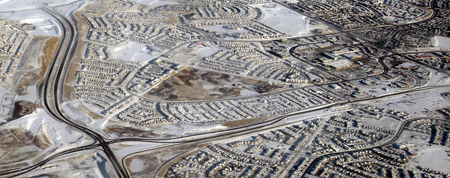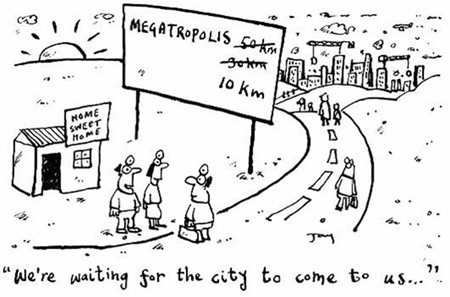"لقد هاجر الناس إلى أطراف المدن ليجدو إسكاناً أكثر بمبالغ أقل. وحتى تتم معادلة هذه الميزة، فستظل العشوائيات هى مستقبلنا" (Alex Krieger, Havard University)
إن عملية إنشاء الضواحى بدأت على مقياس معقول فى العشرينيات وتزايدت سرعتها بعد الحرب العالمية الثانية، خاصة فى أمريكا الشمالية فالولايات المتحدة الأمريكية هى أولى دول العالم فى إقامة الضواحى السائدة. إن التوسع فى الضواحى قد تأثر بالعوامل التالية:
- الضواحى تقابل كلاً من تكاليف الاسكان الجديد وتكاليف النقل المصاحب بالنظر إلى النمو السريع لعدد السكان الحضر وإرتفاع الدخول المستنفذة.
- الإنتشار الواسع للسيارات حسَّن حركة الأفراد.
- الضواحى توفر بيئة الحياة المعينة التى يرغب فيها السكان ويستطيعوا دفع تكاليفها، هرباً من قلب المدن الضيق والتزايد خطورته، والحياة فى مواقع حقول خضراء.
- الحاجة الضخمة للاسكان عند نهاية الحرب العالمية الثانية فى الولايات المتحدة الأمريكية.
- الحاجة إلى توليد عمالة تشغيل بعد الحرب.
- الرهن العقارى المضمون بفائدة ثابته جعل من الأرخص فى حالات كثيرة شراء منزل عن إستئجار شقة.
- برامج الإقراض تشجع على تطوير عائلة مفردة فى بيوت منفصلة بالضواحى.
- أعلنت الأهداف بالوسائل الشعبية التى فضلت إنشاء الطرق السريعة فوق تجمعات كثيفة (Lichtenberger 2002, Mitchell 2007, Pacione 2001).

ضاحية كندية
المصدر: Wikipedia
تفسيرات بديلة لعملية إنشاء الضواحى ↓↑
1. Suburbs as natural ecological extensions:
Suburbanisation as a natural process of organic and evolutionary growth; expansion takes place
from the inside outward to the fringe, but is still tied to the urbanised core for jobs and services.
2. Suburbs as a means of escapism:
As a means of escape from the health, housing and environmental problems of the industrial inner cities.
3. Suburbs as macro-economic policy tools:
Suburbs as Keynesian policy instruments of macro-economic management and regulation, and for generating local employment multipliers.
4. Suburbs as vehicles for capital accumulation:
As a means for landowners, the financial sector and the property industry to capture the social surplus, deriving from the profits from the development of newly built suburban environments on the fringe.
5. Suburbs as a means of social engineering:
As a means of rescuing the poor and the disadvantaged from themselves, and of re-establishing a traditional and presumed superior moral order of earlier times and communities.
6. Suburbs as the logical outcomes of rational locators:
Reflecting the rational decisions of firms and households seeking lower-cost locations and more efficient and less regulated landscapes, within a competitive urban environment.
7. Suburbs as maps of consumer preferences and choices:
Emphasising the dominat role in suburbanisation of the preferences of individual consumers for more space, new housing, social homogeneity and certain public goods.
8. Suburbs as socio-political strategies:
Strategies building on manipulation of the political fragmentation of the metropolis, entrenched local autonomy and the demands for social exclusiveness.
9. Suburbs as asylums:
As defensive strategies, driven by fear of others, of the inner city and by uncertainty over property values, and stressing security and exclusion.
10. Suburbs as rural nostalgia:
Reflecting a desire to return to the countryside and rural roots, but without also severing connections to the urban core (Pacione 2001).
طالما أن الحاجة إلى بيوت منفصلة لكل أسرة منفردة تبقى مرتفعة، فسوف تتحول الأراضى على تخوم المناطق العمرانية من فضاء مفتوح إلى إستخدام أراضى سكنية، ولكن هذا لم يتم بطريقة منظمة "إن حاشية الريف- العمران فى مدن الولايات المتحدة الأمريكية بذلك تشبه الجبن السويسرى، حيث يوجد به جيوب تنمية وفراغات من الفضاء المفتوح " (Renwick, Rubenstein 1995).
أما فى أوروبا , فإمدادات الأرض على امتداد حواف العمران محدودة أكثر ومنظمة، ولذلك فان مثل هذه المناطق الكبيرة للضواحى غير منتشرة جداً.
أشكال أخرى لعمليات العمران
عمليات ضد التمدن، تمدن للخارج، إعادة تمدن ↓↑
عمليات ضد التمدن، تمدن للخارج، إعادة تمدن describes a process where the agglomeration is losing population and a net population movement into smaller urban regions and rural areas. Such signs of a population reversal in rural areas were first identified in the US, similar trends were soon detected in other advanced nations like Canada, Australia, Western Europe and Britain (Pacione 2001).
Exurbanisation is the extended version of suburbanisation when it reaches its greatest extent. Exurbs respresent a transition stage between urban and rural life and are dominated by middle-class residents. In the US, exurbs absorbed 25% of recent national population growth and 60% of recent manufactoring investment. Four principle factors can be identified:
- a continued deconcentration of employment and the rise of exurban industrialisation
- a latent anti-urban and rural location preference of households
- improved technology that makes exurban living possible, and
- an apparent policy bias favouring exurban development over compact development (primary in the USA) (Pacione 2001)
Reurbanisation means a population growth or a reduced population decline in the core of metropolitan areas. This process has not yet emerged as a significant feature in the urban systems. Moreover the process of decentralisation is likely to continue as a major feature of post-industrial urbanisation (Pacione 2001).

العشوائيات العمرانية
المصدر: Windows on our world
مقولات:
"إستمر الحلم الأمريكى طويلاً يوعد بالحياة، والحرية، وتحقيق مطلب بيت واسع لكل أسرة منفردة فى الضواحى (وحتى بحمام سباحة). وقد تم إزاحة الحلم بواسطة كل العوالم المألوفة جداً: أماكن مزدحمة بكثافات مرورية، ضرائب عالية وتلوث: عنف العشوائيات العمرانية." (Mitchell 2007)
"نهاية؟ لماذا لا توجد نهاية منظورة، بالطريقة التى تسير بها. نحن بالكاد نبقى نتحرك أبعد وأبعد للخارج حتى يأتى ذلك اليوم الذى سنحك فيها أذرعنا على إمتداد الطريق عبر أمريكا." (Mitchell 2007)
مهمة: هل إنشاء الضواحى يفضل أن يستمر؟ ماذا يمكن أن يوقف هذا الانتشار؟


